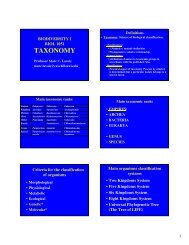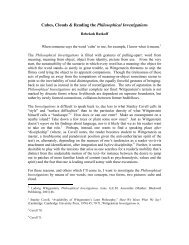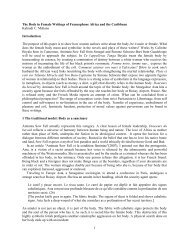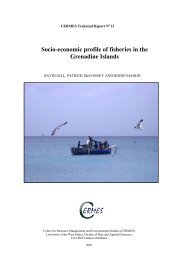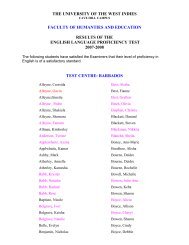Receptors and transduction in taste
Receptors and transduction in taste
Receptors and transduction in taste
Create successful ePaper yourself
Turn your PDF publications into a flip-book with our unique Google optimized e-Paper software.
There is no life form known between bacteria <strong>and</strong><br />
mammals that would neglect to check its <strong>in</strong>take<br />
of matter by chemoreceptive scrut<strong>in</strong>y. A human<br />
baby, only a few days old, already can<br />
dist<strong>in</strong>guish sweet <strong>and</strong> bitter <strong>and</strong> express pleasure<br />
for sweet <strong>taste</strong> but displeasure for bitter <strong>taste</strong> 1 . Inorganic<br />
ions, sugars <strong>and</strong> polysaccharides, am<strong>in</strong>o acids <strong>and</strong><br />
peptides, tox<strong>in</strong>s <strong>and</strong> ‘xenobiotics’ are all subject to<br />
nutritional chemoreception followed by adaptive<br />
behaviour. But details differ widely, depend<strong>in</strong>g on the<br />
complexity of the organism <strong>and</strong> the ecological niche that it<br />
occupies. Even <strong>in</strong> closely related species, dist<strong>in</strong>ct<br />
differences <strong>in</strong> sensory performance may be noted, which<br />
seem to match the nutritional ‘needs’ of a species. To<br />
underst<strong>and</strong> how such a match arose, that is, how receptor<br />
specificity changed with the availability of food<br />
<strong>in</strong>gredients, is perhaps the most fasc<strong>in</strong>at<strong>in</strong>g of the future<br />
tasks of <strong>taste</strong> research.<br />
Taste buds <strong>and</strong> <strong>taste</strong> cells<br />
Already <strong>in</strong> worms, like the model nematode Caenorhabditis<br />
elegans, a dist<strong>in</strong>ction can be made between olfaction <strong>and</strong><br />
<strong>taste</strong> 2 . These two chemoreceptive senses are more clearly<br />
separate <strong>in</strong> arthropods <strong>and</strong> they are quite dist<strong>in</strong>ct <strong>in</strong><br />
vertebrates. In the fruitfly Drosophila melanogaster, for<br />
example, <strong>taste</strong> sensations are mediated by nerve cells of<br />
characteristic topology. Their sensory dendrites are<br />
conta<strong>in</strong>ed <strong>in</strong> ‘hairs’ found on the body surface. Other <strong>taste</strong><br />
neurons, found on the labellum <strong>and</strong> clustered around the<br />
pharynx, express a family of G-prote<strong>in</strong>-coupled receptors<br />
(GPCRs) named GR 3 . This family, however, conta<strong>in</strong>s<br />
c<strong>and</strong>idate receptors for both <strong>taste</strong> <strong>and</strong> olfaction, as its genes<br />
are expressed <strong>in</strong> both gustatory <strong>and</strong> olfactory primary<br />
neurons 4 . In contrast, the <strong>taste</strong> receptor cells of vertebrates<br />
are not neurons, but orig<strong>in</strong>ate from the epithelial cover<strong>in</strong>g of<br />
the body 5 .<br />
Vertebrate <strong>taste</strong> cells are small bipolar cells (Fig. 1). To<br />
connect to the oral space, they send a th<strong>in</strong> dendritic process<br />
to the epithelial surface. The cells occur either s<strong>in</strong>gly or<br />
densely packed <strong>in</strong> <strong>taste</strong> buds, where up to 100 form a<br />
functional unit (Fig. 1a, d). Although <strong>taste</strong> buds also occur<br />
abundantly on the body surface <strong>and</strong> barbels of some fish, all<br />
vertebrates have <strong>taste</strong> buds <strong>in</strong> the oral epithelium, typically<br />
on tongue, palate <strong>and</strong> pharynx. On the tongue, the <strong>taste</strong> buds<br />
are mounted <strong>in</strong> special folds <strong>and</strong> protrusions called<br />
papillae. The marker molecule gustduc<strong>in</strong>, a <strong>taste</strong>-specific<br />
G prote<strong>in</strong> 6 , shows additional ‘<strong>taste</strong> cells’ <strong>in</strong> the nasal mucosa 7<br />
<strong>and</strong> <strong>in</strong> the stomach 8 .<br />
<strong>in</strong>sight review articles<br />
<strong>Receptors</strong> <strong>and</strong> <strong>transduction</strong> <strong>in</strong> <strong>taste</strong><br />
Bernd L<strong>in</strong>demann<br />
Department of Physiology, Universität des Saarl<strong>and</strong>es, D-66421 Homburg, Germany (e-mail: phbl<strong>in</strong>@unikl<strong>in</strong>ik-saarl<strong>and</strong>.de)<br />
Taste is the sensory system devoted primarily to a quality check of food to be <strong>in</strong>gested. Although aided by<br />
smell <strong>and</strong> visual <strong>in</strong>spection, the f<strong>in</strong>al recognition <strong>and</strong> selection relies on chemoreceptive events <strong>in</strong> the mouth.<br />
Emotional states of acute pleasure or displeasure guide the selection <strong>and</strong> contribute much to our quality of<br />
life. Membrane prote<strong>in</strong>s that serve as receptors for the <strong>transduction</strong> of <strong>taste</strong> have for a long time rema<strong>in</strong>ed<br />
elusive. But screen<strong>in</strong>g the mass of genome sequence data that have recently become available has provided a<br />
new means to identify key receptors for bitter <strong>and</strong> sweet <strong>taste</strong>. Molecular biology has also identified<br />
receptors for salty, sour <strong>and</strong> umami <strong>taste</strong>.<br />
A century ago it was determ<strong>in</strong>ed that each chemoreceptive<br />
area of the human tongue responds to each of the<br />
qualities of sweet, sour, salty <strong>and</strong> bitter <strong>taste</strong>. Only m<strong>in</strong>or<br />
differences <strong>in</strong> subjective thresholds were noted across<br />
areas 9,10 . May the time come soon when textbook authors<br />
wake up to this fact! In rodents, the differences <strong>in</strong> thresholds<br />
or sensitivities seem to be somewhat larger 11 . Here, morphological<br />
<strong>and</strong> functional differentiation between buds from the<br />
anterior <strong>and</strong> posterior tongue can be noted more easily, even<br />
though <strong>in</strong>dividual <strong>taste</strong> buds of all areas conta<strong>in</strong> cells<br />
respond<strong>in</strong>g to several qualities.<br />
Lifespan, connectivity <strong>and</strong> cod<strong>in</strong>g<br />
Mammalian <strong>taste</strong>-responsive cells age fast, their lifespan<br />
be<strong>in</strong>g about 10 days. This implies that any one nerve<br />
term<strong>in</strong>al <strong>in</strong> a <strong>taste</strong> bud frequently has to detach from an<br />
age<strong>in</strong>g cell, f<strong>in</strong>d a develop<strong>in</strong>g <strong>taste</strong> cell <strong>and</strong> form new synapses<br />
on its surface. The new cell has presumably to be of appropriate<br />
specificity such that a nerve fibre previously attached<br />
to a Na + -responsive cell, for <strong>in</strong>stance, will aga<strong>in</strong> attach to a<br />
cell of this k<strong>in</strong>d. As <strong>taste</strong> cells of different specificity occur<br />
together <strong>in</strong> one bud, one expects surface markers to guide a<br />
nerve fibre to the right cellular target. In fact, the receptor<br />
molecules themselves may possibly serve as markers, as they<br />
occur not only on the microvilli, but also on basolateral<br />
membrane areas of the receptor cells.<br />
The basic rules for the developmental <strong>in</strong>teractions that<br />
occur between <strong>taste</strong> cells <strong>and</strong> nerve fibres beg<strong>in</strong> to be<br />
deduced us<strong>in</strong>g the methods of molecular biology 12,13 , <strong>and</strong><br />
provide a foundation for a further analysis of the connectivity<br />
<strong>and</strong> the ‘sensory code’ by more function-oriented<br />
approaches such as electrophysiology <strong>and</strong> fluorescence<br />
imag<strong>in</strong>g. Meanwhile, record<strong>in</strong>gs from the sensory nerve<br />
fibres <strong>and</strong> from the soma of their neurons have consistently<br />
revealed the unexpected <strong>and</strong> strik<strong>in</strong>g feature that some nerve<br />
fibres are specialists, but many are generalists, carry<strong>in</strong>g<br />
responses to more than one <strong>taste</strong> quality 14 . A simple ‘labelled<br />
l<strong>in</strong>e’ design, where each fibre responds to just one of the<br />
qualities, to bitter only or to sour only, is not evident, as<br />
many fibres are broadly tuned with respect to <strong>taste</strong> lig<strong>and</strong>s.<br />
These generalist fibres carry responses to salty <strong>and</strong> sour,<br />
to glutamate <strong>and</strong> sucrose, <strong>and</strong> so on. Similarly, many<br />
<strong>taste</strong> receptor cells, too, are generalists, as responses to <strong>taste</strong><br />
qualities are r<strong>and</strong>omly <strong>and</strong> <strong>in</strong>dependently distributed,<br />
vary<strong>in</strong>g <strong>in</strong> <strong>in</strong>tensity across cells 15 . Given such distributed<br />
responses, a part of the <strong>in</strong>formation about <strong>in</strong>dividual<br />
tastants must be buried <strong>in</strong> the quorum of the receptor cells<br />
<strong>and</strong> the ‘across-fibre pattern’ of the sensory nerve 16 . Retrieval<br />
NATURE | VOL 413 | 13 SEPTEMBER 2001 | www.nature.com 219<br />
© 2001 Macmillan Magaz<strong>in</strong>es Ltd
<strong>in</strong>sight review articles<br />
a<br />
c<br />
d<br />
25 µm<br />
of this <strong>in</strong>formation, for <strong>in</strong>stance by pattern discrim<strong>in</strong>ation, will<br />
be one of the ma<strong>in</strong> tasks of central <strong>taste</strong> process<strong>in</strong>g.<br />
<strong>Receptors</strong> <strong>and</strong> <strong>transduction</strong><br />
The bipolar <strong>taste</strong> cells have two specializations of obvious functional<br />
significance: microvilli <strong>in</strong> contact with the oral cavity <strong>and</strong> synapses<br />
with sensory nerve fibres. Taste receptor prote<strong>in</strong>s are mounted on the<br />
microvilli, act<strong>in</strong>g as molecular antennas listen<strong>in</strong>g <strong>in</strong>to the chemical<br />
environment. On b<strong>in</strong>d<strong>in</strong>g <strong>taste</strong> molecules, the receptors trigger <strong>transduction</strong><br />
cascades that activate synapses <strong>and</strong> thus cause excitation of<br />
the nerve fibres. These carry the signal to the bra<strong>in</strong> stem, where central<br />
<strong>taste</strong> process<strong>in</strong>g beg<strong>in</strong>s, ultimately elicit<strong>in</strong>g adaptive responses.<br />
The first molecular encounter with tastants is made therefore by<br />
those membrane prote<strong>in</strong>s — the ‘receptors’ — <strong>in</strong> the apical surface of<br />
b<br />
Taste pore<br />
Tight<br />
junction<br />
Receptor cell<br />
Microvilli<br />
with receptors<br />
Receptor cell<br />
Tight<br />
junction<br />
Microvilli<br />
with receptors<br />
ENaC<br />
CNGgust<br />
V-gated<br />
Na channel<br />
Ca channel<br />
K channels<br />
HCN<br />
ATP-gated K channel<br />
Ca-gated K channel<br />
Ca-gated Cl channel<br />
Others<br />
<strong>taste</strong> receptor cells (Fig. 1b, e). They provide the molecular specificity<br />
of the <strong>taste</strong> response. A plethora of prote<strong>in</strong>s, <strong>in</strong>clud<strong>in</strong>g ion channels,<br />
lig<strong>and</strong>-gated channels, enzymes <strong>and</strong> GPCRs, serve as receptors for<br />
sensory qualities such as salty, sour, sweet, umami <strong>and</strong> bitter<br />
<strong>taste</strong> (Fig. 2), <strong>and</strong> trigger the downstream <strong>transduction</strong> events<br />
with<strong>in</strong> <strong>taste</strong> cells. Included among these events is the fir<strong>in</strong>g of action<br />
potentials, which <strong>taste</strong> cells, like neurons, are able to generate by<br />
means of voltage-gated Na + , K + <strong>and</strong> Ca 2+ channels (Fig. 1e) 17–19 . A<br />
local <strong>in</strong>crease <strong>in</strong> Ca 2+ concentration is needed for synaptic<br />
activation (<strong>and</strong> hence nerve excitation), <strong>and</strong> transient rises <strong>in</strong> the<br />
cytosolic Ca 2+ concentration were observed by fluorescence<br />
imag<strong>in</strong>g (Fig. 1c) <strong>in</strong> <strong>taste</strong> cells respond<strong>in</strong>g to bitter <strong>and</strong> sweet<br />
agents 20–22 , while am<strong>in</strong>o acids triggered either <strong>in</strong>creases or decreases<br />
of the Ca 2+ signal 23,24 .<br />
220 NATURE | VOL 413 | 13 SEPTEMBER 2001 | www.nature.com<br />
© 2001 Macmillan Magaz<strong>in</strong>es Ltd<br />
e<br />
Dendrite<br />
Soma<br />
Synapse<br />
BP<br />
Synapse<br />
Nerve fibre<br />
Figure 1 Morphology of <strong>taste</strong> buds (rat). a, Viable bud isolated from the vallate papilla. Taste pore at the upper left (arrow). Length of bud is 30 m. b, Cut-open view of a bud<br />
(cartoon). Highlighted are two receptor cells with apical microvilli <strong>and</strong> basolateral synapses. c, Images of a viable bud from the vallate papilla, taken with a 2-photon microscope.<br />
The four optical planes depict multiple bipolar cells <strong>in</strong> different states of load<strong>in</strong>g with a fluorescent dye, <strong>and</strong> nerve fibres. d, Three-dimensional reconstruction, from microscopic<br />
serial sections, of a bud from the foliate papilla, the <strong>taste</strong> pore fac<strong>in</strong>g upwards. On the left, a solitary bipolar cell with <strong>in</strong>nervat<strong>in</strong>g nerve fibre is also visible. Scale bar, 25 m.<br />
(Image courtesy of V. I. Popov, Institute of Cell Biophysics, RAS, Pushch<strong>in</strong>o, Russia.). e, Bipolar receptor cell with sensory nerve fibre attached. Some morphological details <strong>and</strong> the<br />
location of the ma<strong>in</strong> types of identified ion channels on the lateral membrane are <strong>in</strong>dicated. BP, basal cell process.<br />
Nerve<br />
fibres
Salty Sour Umami<br />
Bitter Trehalose<br />
(L-glutamate)<br />
(sweet)<br />
α<br />
C C<br />
γ<br />
N N<br />
ENaC/Deg,<br />
others<br />
(refs 34,35)<br />
N N<br />
C C<br />
ENaC, ASIC,<br />
HCN, others<br />
(refs 40,43)<br />
A number of transmitters have been found with<strong>in</strong> <strong>taste</strong> buds, but<br />
those released by <strong>taste</strong> cell synapses have been difficult to identify.<br />
Noradrenal<strong>in</strong>e <strong>and</strong> acetylchol<strong>in</strong>e seem to be secreted by nerve fibres<br />
<strong>and</strong> modulate the responses of <strong>taste</strong> cells 25,26 . Seroton<strong>in</strong> is thought to<br />
act as a paracr<strong>in</strong>e agent between <strong>taste</strong> cells. Secreted by one cell <strong>and</strong><br />
modulat<strong>in</strong>g the <strong>taste</strong> response of a neighbour<strong>in</strong>g cell, this agent<br />
mediates local signal process<strong>in</strong>g with<strong>in</strong> a <strong>taste</strong> bud 27,28 . Glutamate is a<br />
strong c<strong>and</strong>idate for a ma<strong>in</strong>stream afferent transmitter secreted by<br />
<strong>taste</strong> cell synapses 29,30 .<br />
Salt <strong>taste</strong><br />
Two <strong>taste</strong> qualities detect ions <strong>in</strong> the oral space: salt <strong>and</strong> sour <strong>taste</strong>.<br />
Salt <strong>taste</strong> guides the <strong>in</strong>corporation of NaCl <strong>and</strong> other required m<strong>in</strong>erals,<br />
thus serv<strong>in</strong>g an essential function <strong>in</strong> ion <strong>and</strong> water homeostasis. It<br />
shows variations across animal species, depend<strong>in</strong>g on the ion content<br />
of the characteristic diet 19 .<br />
Although salt <strong>taste</strong> is elicited by many ionic species, the component<br />
due to the presence of Na + ions may be the most relevant for mammals<br />
<strong>and</strong> is certa<strong>in</strong>ly the best studied 31 . The Na + <strong>taste</strong>, <strong>in</strong> turn, is composed<br />
of a Na + -specific <strong>and</strong> a nonspecific mechanism. It was long suspected<br />
that a sodium channel sensitive to the channel-blocker amiloride<br />
serves as a salt receptor 32 . This conjecture holds especially for rodents,<br />
where the Na + -specific salt <strong>taste</strong> is <strong>in</strong>deed mediated by a highly Na + -<br />
selective channel known as ENaC, the amiloride-sensitive epithelial<br />
sodium channel 33 . ENaC is a hetero-oligomeric complex compris<strong>in</strong>g<br />
three homologous subunits (Fig. 2), which acts as a salt-<strong>taste</strong> receptor<br />
by provid<strong>in</strong>g a specific pathway for sodium current <strong>in</strong>to <strong>taste</strong> cells,<br />
provided that Na + ions are present <strong>in</strong> the oral space <strong>in</strong> sufficient concentration<br />
34,35 . The current triggers action potentials at the basolateral<br />
membrane of the <strong>taste</strong> cell 36 , followed by synaptic events.<br />
Of the three essential subunits of ENaC, at least one is under<br />
<strong>in</strong>ductive control by a steroid hormone, aldosterone 35 . Thus the<br />
sensitivity of sodium <strong>taste</strong> is <strong>in</strong>creased <strong>in</strong> animals <strong>in</strong> sodium-need<br />
through <strong>in</strong>duction of more ENaC channels. A systemic Na + deficiency,<br />
which leads to salt crav<strong>in</strong>g, occurs regularly <strong>in</strong> herbivores, but can<br />
be observed also <strong>in</strong> rodents <strong>and</strong> humans. The <strong>in</strong>duction of ENaC<br />
subunits <strong>in</strong> vallate <strong>taste</strong> buds by circulat<strong>in</strong>g aldosterone provides an<br />
<strong>in</strong>structive example for adaptive tun<strong>in</strong>g of <strong>taste</strong> acuity <strong>in</strong> a state of<br />
nutritional deficiency.<br />
In humans, the amiloride sensitivity of salt <strong>taste</strong> is less<br />
pronounced 37 , suggest<strong>in</strong>g the <strong>in</strong>volvement of another, as yet unspecified<br />
channel. It is ironic that so little is known especially about the<br />
molecular foundation of human salt <strong>taste</strong>.<br />
Sour <strong>taste</strong><br />
Sour <strong>taste</strong> is acceptable or <strong>in</strong>terest<strong>in</strong>g when mild, thereby aid<strong>in</strong>g the<br />
recognition of complex food, but it becomes <strong>in</strong>creas<strong>in</strong>gly unpleasant<br />
N<br />
X<br />
C<br />
Taste mGluR4,<br />
others<br />
(ref. 94)<br />
Figure 2 Taste receptors of known primary structure, discovered 1998–2001.<br />
N N<br />
<strong>in</strong>sight review articles<br />
when strong 1 . It serves to detect unripe fruits <strong>and</strong> spoiled food, <strong>and</strong> to<br />
avoid tissue damage by acids <strong>and</strong> problems of systemic acid–base<br />
regulation.<br />
The receptors proposed for sour <strong>taste</strong> <strong>in</strong> mammals can be ordered<br />
<strong>in</strong> two groups. The first comprises channels that conduct an <strong>in</strong>ward<br />
proton current if protons are available <strong>in</strong> the oral space. ENaC has this<br />
property 38 . The second group comprises H + -gated channels,<br />
<strong>in</strong>clud<strong>in</strong>g the apical K + channel of the mudpuppy Necturus 39 ,<br />
MDEG1 of the ENaC/Deg family 40 , an unspecific H + -gated cation<br />
channel 41,42 , <strong>and</strong> HCN, the hyperpolarization-activated, cyclic<br />
nucleotide-gated cation channel 43 . The large variety of mechanisms<br />
found for sour <strong>taste</strong> highlights the complexity of <strong>taste</strong> <strong>transduction</strong>.<br />
To some extent, the <strong>in</strong>tracellular pH of <strong>taste</strong> cells follows extracellular<br />
changes <strong>in</strong> pH, especially when the extracellular changes extend<br />
over the basolateral membrane. This probably occurs because the<br />
tight junction, which closes the extracellular space of a <strong>taste</strong> bud<br />
towards the oral space (Fig. 1b), is permeable to H + ions 44 . H + ions<br />
may therefore <strong>in</strong>vade the <strong>taste</strong> bud <strong>and</strong> <strong>in</strong>itiate <strong>in</strong>tracellular ‘pH<br />
track<strong>in</strong>g’, which is thought to contribute to sour <strong>transduction</strong> 45 .<br />
Bitter <strong>taste</strong><br />
Bitter <strong>taste</strong> is unpleasant though bearable when weak, but repulsive<br />
when strong. Many organic molecules, orig<strong>in</strong>at<strong>in</strong>g from plants <strong>and</strong><br />
<strong>in</strong>terfer<strong>in</strong>g with the <strong>in</strong>ternal signall<strong>in</strong>g system of animals <strong>and</strong><br />
humans, are bitter, <strong>in</strong>clud<strong>in</strong>g caffe<strong>in</strong>e, nicot<strong>in</strong>e <strong>and</strong> strychn<strong>in</strong>e, <strong>and</strong><br />
the same is true for many drugs produced by <strong>in</strong>dustry 46 . Bitter <strong>taste</strong><br />
effectively warns us not to <strong>in</strong>gest potentially harmful compounds.<br />
One of the excit<strong>in</strong>g challenges <strong>in</strong> <strong>taste</strong> research is to underst<strong>and</strong> how<br />
bitter receptors were shaped by evolution to serve this task.<br />
By scann<strong>in</strong>g genomic databases near a promis<strong>in</strong>g bitter locus on<br />
mouse chromosome 6, a group of new GPCRs was discovered, the<br />
T2R family 47,48 . The receptors had short am<strong>in</strong>o-term<strong>in</strong>al doma<strong>in</strong>s<br />
(NTDs) (Fig. 2) <strong>and</strong> were expressed specifically <strong>in</strong> a subset of <strong>taste</strong><br />
cells. The large size of this family, with 40–80 members orig<strong>in</strong>ally<br />
specified 47 , came as a surprise. Three of the receptors could be<br />
expressed <strong>in</strong> a cell l<strong>in</strong>e, where they responded to bitter tastants 49 . In<br />
humans, the T2R family comprises at least 24 genes cod<strong>in</strong>g for<br />
GPCRs, distributed over three chromosomes (B. Bufe <strong>and</strong> W. Meyerhof,<br />
personal communication).<br />
It is likely but not yet certa<strong>in</strong> that all 24 GPCRs of the T2R family<br />
respond to bitter agents. How are these GPCRs distributed across <strong>taste</strong><br />
cells? Adler et al. concluded from <strong>in</strong> situ hybridization data 47 that “a<br />
s<strong>in</strong>gle <strong>taste</strong> receptor cell expresses a large repertoire of T2Rs,<br />
suggest<strong>in</strong>g that each cell may be capable of recogniz<strong>in</strong>g multiple<br />
tastants”. Caicedo <strong>and</strong> Roper have probed this question differently, by<br />
us<strong>in</strong>g functional imag<strong>in</strong>g experiments. They found that most<br />
bitter-responsive <strong>taste</strong> cells, which presumably expressed T2Rs, were<br />
NATURE | VOL 413 | 13 SEPTEMBER 2001 | www.nature.com 221<br />
© 2001 Macmillan Magaz<strong>in</strong>es Ltd<br />
C<br />
T2R family,<br />
others<br />
(refs 47-49)<br />
C<br />
Predicted receptor<br />
of Drosophila<br />
(ref. 69)<br />
Predicted sweet<br />
receptor<br />
N<br />
C<br />
T1R3 (sac locus)<br />
(refs 72-75)<br />
Sweet receptor,<br />
functional as<br />
heterodimer<br />
N<br />
T1R2/T1R3<br />
(refs 76,77)<br />
C
<strong>in</strong>sight review articles<br />
activated by only one out of five compounds tested. Thus, the tun<strong>in</strong>g of<br />
receptor cells with respect to bitter compounds seems to be more<br />
focused than anticipated, <strong>and</strong> different bitter stimuli may activate,<br />
through the GPCRs expressed, different subpopulations of bittersensitive<br />
<strong>taste</strong> cells 22 . In agreement with this f<strong>in</strong>d<strong>in</strong>g, s<strong>in</strong>gle <strong>taste</strong> nerve<br />
fibres carry signals that discrim<strong>in</strong>ate between bitter compounds 50 .<br />
It is not only GPCRs that act as bitter receptors. Some bitter peptides<br />
with amphophilic properties <strong>in</strong>teract directly with G prote<strong>in</strong>s,<br />
probably by virtue of a structural similarity to the G-prote<strong>in</strong>-b<strong>in</strong>d<strong>in</strong>g<br />
site of the receptor 46 . Qu<strong>in</strong><strong>in</strong>e, also an amphophilic compound,<br />
permeates the cell membrane <strong>and</strong> activates G prote<strong>in</strong>s, bypass<strong>in</strong>g the<br />
receptor 51 . In Necturus, qu<strong>in</strong><strong>in</strong>e blocks apical K + channels 52 , whereas<br />
<strong>in</strong> the bullfrog, it activates a cation conductance <strong>in</strong> <strong>taste</strong> cells 53 .<br />
Denatonium blocks voltage-gated delayed-rectifier K + channels 54 .<br />
Caffe<strong>in</strong>e <strong>and</strong> other methyl-xanth<strong>in</strong>es also act without activat<strong>in</strong>g a<br />
GPCR (Fig. 3). After permeat<strong>in</strong>g the cell membrane they block an<br />
<strong>in</strong>tracellular phosphodiesterase <strong>and</strong> cause activation of a soluble<br />
guanylate cyclase 55 . The latter effect may be under control of nitric oxide,<br />
as nitric oxide synthase was found <strong>in</strong> <strong>taste</strong> cells 56 . As the result of these<br />
complex events, a transient <strong>in</strong>crease <strong>in</strong> guanid<strong>in</strong>e 3,5-cyclic<br />
monophosphate (cGMP) was measured with stopped-flow methods 55 .<br />
Bitter-<strong>taste</strong> <strong>transduction</strong><br />
Members of the T2R family were found co-expressed with the -subunit<br />
of the G prote<strong>in</strong> gustduc<strong>in</strong> 47 , a <strong>taste</strong>-specific signall<strong>in</strong>g prote<strong>in</strong><br />
long known to have a prom<strong>in</strong>ent role <strong>in</strong> bitter <strong>taste</strong> 6 . Knockout mice<br />
lack<strong>in</strong>g -gustduc<strong>in</strong> show decreased sensitivity for bitter agents such as<br />
denatonium <strong>and</strong> qu<strong>in</strong><strong>in</strong>e, <strong>and</strong> also for sweet agents such as sacchar<strong>in</strong><br />
<strong>and</strong> sucrose 57 . -Gustduc<strong>in</strong> activates a <strong>taste</strong>-specific phosphodiesterase<br />
58 , lower<strong>in</strong>g the cellular concentration of cyclic nucleotides 59 .<br />
Another <strong>transduction</strong> cascade is also activated simultaneously by<br />
the GPCR-mediated bitter signal (Fig. 3). Of the - <strong>and</strong> -subunits of<br />
heterotrimeric gustduc<strong>in</strong> 60 , G13 <strong>and</strong> G3 are able to activate<br />
phospholipase C2 (PLC2; refs 60–62), lead<strong>in</strong>g to the generation of<br />
<strong>in</strong>ositol-1,4,5-trisphosphate (Ins(1,4,5)P 3) 63,64 . This messenger activates<br />
Ins(1,4,5)P 3 receptors of <strong>in</strong>tracellular Ca 2+ stores, of which the<br />
type III receptor, which may be modulated by calcium ions <strong>and</strong> by<br />
cAMP-dependent k<strong>in</strong>ases, is the dom<strong>in</strong>ant form 65 . The receptor is<br />
co-expressed with PLC2 (ref. 66). Concomitantly, Ca 2+ ions are<br />
released <strong>in</strong>to the cytosol 20,21,67 . The subsequent elements of <strong>transduction</strong>,<br />
that is, the channels responsible for a change <strong>in</strong> membrane<br />
potential, rema<strong>in</strong> to be identified.<br />
Thus, the GPCR-mediated bitter signal triggers a transient<br />
decrease <strong>in</strong> cAMP <strong>and</strong> cGMP, accompanied by a transient <strong>in</strong>crease <strong>in</strong><br />
Ins(1,4,5)P 3 (refs 59, 64). Whether the two pathways, which are<br />
activated simultaneously, are connected, with the decrease <strong>in</strong> cyclic<br />
nucleotides enabl<strong>in</strong>g the <strong>in</strong>crease <strong>in</strong> Ins(1,4,5)P 3, has not yet been<br />
determ<strong>in</strong>ed. Furthermore, it is unclear why dual signall<strong>in</strong>g should<br />
be required for bitter <strong>taste</strong>, <strong>and</strong> whether or not it is more than<br />
parallel amplification. A similar design is not found <strong>in</strong> the receptor<br />
cells of other senses, <strong>and</strong> the other major chemoreceptive organ —<br />
the nose — seems to do well without it (see review <strong>in</strong> this issue by<br />
Fireste<strong>in</strong>, pages 211–218).<br />
Sweet <strong>taste</strong><br />
Sweet <strong>taste</strong> responds to soluble carbohydrates present <strong>in</strong> sufficient<br />
concentrations <strong>in</strong> the oral cavity, guid<strong>in</strong>g high-calorie <strong>in</strong>take. Yet a<br />
wide diversity of non-carbohydrate molecules is also sweet. Sweet<br />
<strong>taste</strong> has a strong hedonic (pleasant) effect 1 .<br />
Considerable efforts have been made by chemists <strong>and</strong> researchers<br />
<strong>in</strong> food-produc<strong>in</strong>g companies to deduce from hundreds of sweettast<strong>in</strong>g<br />
compounds common structural features that were expected<br />
to capture characteristics of ‘the’ sweet molecule <strong>and</strong>, therefore, ‘the’<br />
sweet receptor. The b<strong>in</strong>d<strong>in</strong>g-site models obta<strong>in</strong>ed seemed realistic <strong>in</strong><br />
that they could be used to design new high-potency sweeteners 68 . The<br />
time has come, however, to def<strong>in</strong>e sweet receptors more directly<br />
us<strong>in</strong>g the tools of genetics <strong>and</strong> molecular biology.<br />
A first success was achieved by clon<strong>in</strong>g a c<strong>and</strong>idate trehalose<br />
receptor of Drosophila 69 . It is a GPCR that has only a short NTD<br />
(Fig. 2). In the mouse genome, sweet-receptor genes are most likely<br />
located on chromosome 4, where two sweet <strong>taste</strong>-related locations<br />
are found, the Dpa locus <strong>and</strong> the Sac locus 70,71 . Mutations <strong>in</strong> the Dpa<br />
locus resulted <strong>in</strong> a partial loss of <strong>taste</strong> acuity for the sweet am<strong>in</strong>o acid<br />
D-phenylalan<strong>in</strong>e, whereas mutations <strong>in</strong> the Sac locus caused a partial<br />
loss of <strong>taste</strong> acuity for sucrose, sacchar<strong>in</strong> <strong>and</strong> other sweeteners.<br />
Search<strong>in</strong>g the new genomic databases near these two loci may<br />
uncover genes for sweet receptors.<br />
When applied recently to the Sac locus, this strategy proved<br />
remarkably successful. The receptor T1R3, found simultaneously by<br />
four laboratories 72–75 , has a large NTD (Fig. 2), just like the orphan<br />
receptors T1R1 <strong>and</strong> T1R2 described previously 76 . T1R3 was found <strong>in</strong><br />
buds of the anterior, lateral <strong>and</strong> posterior tongue. It is expressed <strong>in</strong><br />
many <strong>taste</strong> cells which also express the orphan T1R2, suggest<strong>in</strong>g that<br />
the two receptors serve a common function. They might, for<br />
<strong>in</strong>stance, form heterodimers, as is known from some other GPCRs<br />
with large NTDs 72,73 .<br />
As the gene Tas1r3 is the only GPCR-cod<strong>in</strong>g gene at the Sac locus,<br />
its product T1R3 is a strong c<strong>and</strong>idate for a sweet receptor. This conjecture<br />
is supported by additional observations. First, stra<strong>in</strong>s of mice<br />
that differ <strong>in</strong> sweet-<strong>taste</strong> ability also differ by several po<strong>in</strong>t mutations<br />
<strong>in</strong> Tas1r3. These changes do not affect expression, but may result <strong>in</strong> a<br />
decl<strong>in</strong>e of function. Of course, ow<strong>in</strong>g to extended polymorphism, the<br />
stra<strong>in</strong>s also differ by many more mutations outside of Tas1r3. Second,<br />
<strong>in</strong>breed<strong>in</strong>g of <strong>taste</strong>r <strong>and</strong> non-<strong>taste</strong>r stra<strong>in</strong>s revealed a correlation<br />
between alleles received <strong>and</strong> sweet-<strong>taste</strong> acuity 73 . In the future, a more<br />
detailed proof might show that transgenic non-<strong>taste</strong>r mice become<br />
<strong>taste</strong>rs when Tas1r3 is switched on. The <strong>in</strong>k was not yet dry on the<br />
c<strong>and</strong>idate sweet receptor T1R3, when Charles Zuker <strong>and</strong> co-workers<br />
managed to express this GPCR <strong>in</strong> oocytes. They found that the receptor<br />
does not respond to sweeteners on its own. But responses were<br />
obta<strong>in</strong>ed after co-express<strong>in</strong>g T1R3 together with T1R2, show<strong>in</strong>g that<br />
the first functional sweet receptor found <strong>in</strong> mammals is a dimer 77 .<br />
Sweet-<strong>taste</strong> <strong>transduction</strong><br />
How is T1R3 coupled to the <strong>transduction</strong> mach<strong>in</strong>ery? This GPCR is<br />
expressed by about 20% of the <strong>taste</strong> cells, some of which also express<br />
-gustduc<strong>in</strong>. The precise extent of co-expression is debatable, however,<br />
as one group found that less than 20% of the T1R3 cells have a<br />
222 NATURE | VOL 413 | 13 SEPTEMBER 2001 | www.nature.com<br />
© 2001 Macmillan Magaz<strong>in</strong>es Ltd<br />
NOS<br />
NO<br />
Caffe<strong>in</strong>e<br />
Theophyll<strong>in</strong>e<br />
PDE PDE<br />
cGMP,<br />
transient<br />
<strong>in</strong>crease<br />
sGC<br />
R<br />
Cont<strong>in</strong>uous<br />
source?<br />
Cycloheximide<br />
Nicot<strong>in</strong>e, Strichn<strong>in</strong>e<br />
Qu<strong>in</strong><strong>in</strong>e, Denatonium<br />
Others<br />
α<br />
cAMP, cGMP<br />
transient<br />
decrease<br />
βγ<br />
PLC<br />
β2<br />
IP3<br />
transient<br />
<strong>in</strong>crease<br />
Ca 2+<br />
DAG<br />
Figure 3 Transduction of bitter <strong>taste</strong> as elicited by a variety of lig<strong>and</strong>s. Rs, multiple<br />
GPCRs of the T2R family, coupled to the G prote<strong>in</strong> gustduc<strong>in</strong> 47–49 ; , -subunit of<br />
gustduc<strong>in</strong> 6,57 ; , G-prote<strong>in</strong> subunits 3 <strong>and</strong> 13 (refs 60–62); PLC2,<br />
phospholipase C subtype 61 ; Ins(1,4,5)P 3, <strong>in</strong>ositol-1,4,5-trisphosphate 59 ; PDE, <strong>taste</strong>specific<br />
phosphodiesterase 58 ; cAMP, cyclic adenos<strong>in</strong>e monophosphate 59 ; cGMP,<br />
cyclic guanos<strong>in</strong>e monophosphate 59 ; sGC, soluble guanylate cyclase 55 ; NO, nitric<br />
oxide 55 ; NOS, NO synthase 56 . For second-messenger k<strong>in</strong>etics, see refs 55,59,63,64.
measurable gustduc<strong>in</strong> signal 73 , whereas another specified a much<br />
larger percentage 72 . The co-expression is compatible with a role of<br />
-gustduc<strong>in</strong> <strong>in</strong> sweet <strong>taste</strong>, as data obta<strong>in</strong>ed from knockout mice had<br />
suggested previously 57 . If the fraction of cells that co-express T1R3<br />
with -gustduc<strong>in</strong> is as low as 20%, then the co-express<strong>in</strong>g cells may be<br />
generalists, respond<strong>in</strong>g to both sweet <strong>and</strong> bitter signals. In this case,<br />
-gustduc<strong>in</strong> would be a hallmark of bitter <strong>transduction</strong>, but would<br />
not be present <strong>in</strong> most sweet-responsive cells, which ignore the bitter<br />
signal. Many of the <strong>taste</strong> cells co-express<strong>in</strong>g T1R3 <strong>and</strong> -gustduc<strong>in</strong><br />
also express G3, G13 <strong>and</strong> PLC2 (ref. 72), all <strong>transduction</strong><br />
elements of bitter <strong>taste</strong> (Fig. 3).<br />
Like bitter-responsive cells, sweet-responsive cells use both cyclic<br />
nucleotides <strong>and</strong> Ins(1,4,5)P 3 as second messengers (Fig. 4).<br />
Ca 2+ -imag<strong>in</strong>g experiments with isolated <strong>taste</strong> buds of rat vallate<br />
orig<strong>in</strong> showed that stimulation with sugars or with forskol<strong>in</strong> caused<br />
Ca 2+ uptake from the extracellular space, whereas non-sugar sweeteners<br />
caused Ca 2+ release from <strong>in</strong>tracellular stores 21 . This, together<br />
with other data, suggested that sugars activate a cyclic nucleotide<br />
cascade, lead<strong>in</strong>g to an <strong>in</strong>crease of cAMP, membrane depolarization<br />
<strong>and</strong> Ca 2+ uptake, whereas non-sugar sweeteners activate the<br />
Ins(1,4,5)P 3 cascade <strong>in</strong> the same cell 21 . This notion was compatible<br />
with results from several laboratories, some of which <strong>in</strong>volved <strong>in</strong>hibition<br />
of a K + conductance as the depolariz<strong>in</strong>g step 18,78–87 . Inhibition of<br />
the K + conductance was thought orig<strong>in</strong>ally to occur through prote<strong>in</strong><br />
k<strong>in</strong>ase A (PKA) 78 , but a cyclic nucleotide-gated channel, the CNG gust,<br />
that was found <strong>in</strong> <strong>taste</strong> cells 88 might contribute to depolarization <strong>and</strong><br />
Ca 2+ <strong>in</strong>flow when cAMP <strong>in</strong>creases (Fig. 4). A co-localization of the<br />
channel with T1R3 or -gustduc<strong>in</strong> has not yet been reported.<br />
More recent evidence <strong>in</strong>dicates modifications regard<strong>in</strong>g the role<br />
of cAMP <strong>in</strong> sweet <strong>taste</strong> (Fig. 4). An <strong>in</strong>hibitor of PKA was found not to<br />
<strong>in</strong>hibit the sugar-sweet response <strong>in</strong> the hamster anterior tongue, but<br />
to enhance it 89 . This <strong>in</strong>dicates that PKA is not <strong>in</strong>volved directly <strong>in</strong> the<br />
response to sugars, but may be <strong>in</strong>volved <strong>in</strong> adaptation. The response<br />
to artificial sweeteners was also enhanced. In contrast, <strong>in</strong>hibition of<br />
prote<strong>in</strong> k<strong>in</strong>ase C did not affect responses to sucrose, but <strong>in</strong>hibited<br />
responses to artificial sweeteners. This showed aga<strong>in</strong> that the <strong>transduction</strong><br />
of the two k<strong>in</strong>ds of sweeteners differs. Inhibition of the<br />
Ca 2+ /calmodul<strong>in</strong>-dependent cAMP-phosphodiesterase enhanced<br />
the responses to sucrose but not to synthetic sweeteners, <strong>in</strong>dicat<strong>in</strong>g<br />
that the calcium ions released dur<strong>in</strong>g stimulation with synthetic<br />
sweeteners may depress a simultaneous response to sucrose by<br />
activation of this enzyme 89 .<br />
Furthermore, it was found with improved record<strong>in</strong>g conditions<br />
that <strong>in</strong> the vallate papilla of the rat the second messenger cGMP rose<br />
transiently, with a peak-time of 150 ms, <strong>in</strong> response to sucrose. This<br />
signal was observed only as long as cAMP rema<strong>in</strong>ed low, suggest<strong>in</strong>g<br />
that cGMP is <strong>in</strong>volved <strong>in</strong> the <strong>in</strong>itial stage of sugar-<strong>taste</strong> <strong>transduction</strong><br />
<strong>and</strong> may be more significant than cAMP at this stage 90 .<br />
In conclusion, sweet-<strong>taste</strong> <strong>transduction</strong> is complex <strong>and</strong> our<br />
knowledge about it is far from complete. The data presently available<br />
suggest that sweet stimuli activate <strong>taste</strong> cells through at least two<br />
<strong>transduction</strong> pathways (Fig. 4), of which one <strong>in</strong>volves an <strong>in</strong>crease <strong>in</strong><br />
cyclic nucleotides (cGMP or cAMP), the other an <strong>in</strong>crease <strong>in</strong><br />
Ins(1,4,5)P 3. Membrane depolarization by <strong>in</strong>hibition of a K + conductance<br />
may be a common feature of the two pathways. An <strong>in</strong>crease<br />
<strong>in</strong> the cytosolic Ca 2+ concentration occurs <strong>in</strong> both of the pathways,<br />
even though the source of the Ca 2+ ions is different. There seems to be<br />
variability <strong>in</strong> utilization of the pathways across the anterior <strong>and</strong><br />
posterior regions of the tongue <strong>and</strong> across sweeteners <strong>and</strong> animal<br />
species. Now that c<strong>and</strong>idates for sweet receptors are known, new<br />
biochemical experiments may soon identify the <strong>transduction</strong><br />
elements downstream of the receptors.<br />
Like other <strong>taste</strong> qualities, sweet <strong>taste</strong> is modified by circulat<strong>in</strong>g<br />
hormones. Recently, the effect of lept<strong>in</strong> on sweet-respond<strong>in</strong>g <strong>taste</strong><br />
cells has generated much <strong>in</strong>terest. Lept<strong>in</strong>, a prote<strong>in</strong> hormone encoded<br />
by the ob gene, is secreted ma<strong>in</strong>ly by adipocytes <strong>and</strong> regulates body<br />
mass. The full-length lept<strong>in</strong> receptor Ob-Rb, a pr<strong>in</strong>cipal mediator of<br />
<strong>in</strong>sight review articles<br />
the lept<strong>in</strong> signal, is expressed <strong>in</strong> various tissues <strong>in</strong>clud<strong>in</strong>g pancreatic<br />
-cells <strong>and</strong> a subset of <strong>taste</strong> cells 91,92 . Lept<strong>in</strong> suppresses <strong>in</strong>sul<strong>in</strong><br />
secretion by the activation of ATP-sensitive K + channels. Its <strong>in</strong>hibitory<br />
effect on <strong>taste</strong> receptor cells also <strong>in</strong>volves the activation of a K +<br />
conductance <strong>and</strong> membrane hyperpolarization 91 . Thereby the<br />
hormone partially blunts nerve signals <strong>in</strong>dicat<strong>in</strong>g sweet <strong>taste</strong>, which,<br />
presumably, makes food less attractive. Dur<strong>in</strong>g starvation the<br />
production of lept<strong>in</strong> is decreased. The result<strong>in</strong>g dis<strong>in</strong>hibition <strong>in</strong> the<br />
target tissues dim<strong>in</strong>ishes energy expenditure <strong>and</strong> leads to the motivational<br />
state of hunger. At the same time, dis<strong>in</strong>hibition of<br />
sweet-responsive <strong>taste</strong> cells enhances sensitivity to sweet <strong>taste</strong>,<br />
mak<strong>in</strong>g sweet food more attractive. Thus the effect of lept<strong>in</strong> on the<br />
<strong>taste</strong> system supports the general role of this hormone <strong>in</strong> regulat<strong>in</strong>g<br />
nutrition, body weight <strong>and</strong> energy balance 92 .<br />
Umami <strong>taste</strong><br />
The biological significance of this basic <strong>taste</strong>, discovered about 100<br />
years ago, is high, comparable perhaps to that of sweet <strong>taste</strong>. ‘Umami’,<br />
a term derived from the Japanese umai (delicious), designates a<br />
pleasant <strong>taste</strong> sensation which is qualitatively different from sweet,<br />
salty, sour <strong>and</strong> bitter 93 . Umami is a dom<strong>in</strong>ant <strong>taste</strong> of food conta<strong>in</strong><strong>in</strong>g<br />
L-glutamate, like chicken-broth, meat extracts <strong>and</strong> age<strong>in</strong>g cheese.<br />
The rather common am<strong>in</strong>o acid L-glutamate thus guides the <strong>in</strong>take of<br />
peptides <strong>and</strong> prote<strong>in</strong>s, from which it is released by proteolysis (cur<strong>in</strong>g<br />
<strong>and</strong> decay). Characteristic <strong>taste</strong>-enhanc<strong>in</strong>g effects arise from the<br />
presence of pur<strong>in</strong>e 5-ribonucleotides such as IMP <strong>and</strong> GMP, which<br />
are also present <strong>in</strong> decay<strong>in</strong>g biological tissues.<br />
A <strong>taste</strong> receptor for L-glutamate might possibly be related to one of<br />
the glutamate receptors well known from neuronal synapses. Start<strong>in</strong>g<br />
with this hypothesis, it was discovered that a subset of <strong>taste</strong> cells<br />
conta<strong>in</strong>s a truncated form of bra<strong>in</strong> mGluR4, a metabotropic GPCR<br />
abundant <strong>in</strong> the central nervous system. Although bra<strong>in</strong> mGluR4 has<br />
a rather large NTD, the <strong>taste</strong> variant has a truncated NTD (Fig. 2) <strong>and</strong><br />
this seems to adapt the receptor to the high glutamate concentrations<br />
occurr<strong>in</strong>g <strong>in</strong> food 94 . Synergism with ribonucleotides, a highlight of<br />
umami <strong>taste</strong>, was established 95 . Once aga<strong>in</strong>, the <strong>transduction</strong> is<br />
complex — one variant <strong>in</strong>volves the susta<strong>in</strong>ed closure of an<br />
unspecific cation conductance, presumably caus<strong>in</strong>g hyperpolarization,<br />
even though transient <strong>in</strong>ward currents, which would cause<br />
NATURE | VOL 413 | 13 SEPTEMBER 2001 | www.nature.com 223<br />
© 2001 Macmillan Magaz<strong>in</strong>es Ltd<br />
Ca 2+<br />
K +<br />
AC<br />
cAMP<br />
Sucrose<br />
PDE<br />
W7<br />
R<br />
Synthetic<br />
?<br />
?<br />
PKA H89<br />
CAM<br />
R<br />
PLC<br />
IP 3<br />
Ca 2+<br />
DAG<br />
PKC<br />
Figure 4 Molecules <strong>in</strong>volved <strong>in</strong> the <strong>transduction</strong> of sweet <strong>taste</strong>. Two separate sweet<br />
receptors are shown, but the possibility that one receptor activates both of the<br />
<strong>transduction</strong> pathways 100 is not excluded at this stage. R, c<strong>and</strong>idate receptor(s) 72–75 ;<br />
AC, adenylate cyclase 81,82,87 ; cAMP, cyclic adenos<strong>in</strong>e monophosphate 21 ; PDE,<br />
phosphodiesterase, <strong>in</strong>hibitor W7 (ref. 89); CAM, calmodul<strong>in</strong> 89 ; PKA, prote<strong>in</strong> k<strong>in</strong>ase A,<br />
<strong>in</strong>hibitor H89 (ref. 89); PLC, phospholipase C 89 ; DAG, diacylglycerol; Ins(1,4,5)P 3,<br />
<strong>in</strong>ositol-1,4,5-trisphosphate 21 ; PKC, prote<strong>in</strong> k<strong>in</strong>ase C, <strong>in</strong>hibitor bim<br />
(bis<strong>in</strong>dolylmaleimide) 89 . For crosstalk between pathways <strong>and</strong> effects of <strong>in</strong>hibitors<br />
(H89, bim <strong>and</strong> W7), see ref. 89.<br />
bim<br />
K +
<strong>in</strong>sight review articles<br />
depolarization, were also observed 96,97 . In addition to the <strong>taste</strong><br />
mGluR4, other glutamate <strong>and</strong> am<strong>in</strong>o-acid receptors were also found<br />
to function <strong>in</strong> <strong>taste</strong> cells 23,24,98 .<br />
Perspectives for <strong>taste</strong> research<br />
Much effort is now be<strong>in</strong>g made to identify the receptors <strong>and</strong> other key<br />
molecules of <strong>transduction</strong> with<strong>in</strong> <strong>taste</strong> receptor cells. The sequenc<strong>in</strong>g<br />
of the receptor genetic code <strong>in</strong> particular opens the way to study the<br />
correspond<strong>in</strong>g prote<strong>in</strong>s <strong>and</strong> map their structure with good spatial<br />
resolution. In this way, we should achieve a better underst<strong>and</strong><strong>in</strong>g of<br />
how the prote<strong>in</strong> mach<strong>in</strong>ery with<strong>in</strong> <strong>taste</strong> GPCRs actually works.<br />
The practical consequences of these efforts are considerable.<br />
Based on b<strong>in</strong>d<strong>in</strong>g-site structure, advanced techniques of drug design<br />
are expected to allow the construction of <strong>taste</strong> lig<strong>and</strong>s that activate or<br />
<strong>in</strong>hibit a receptor prote<strong>in</strong>, thereby enhanc<strong>in</strong>g or <strong>in</strong>hibit<strong>in</strong>g a specific<br />
<strong>taste</strong>. Thus it might become possible to exp<strong>and</strong> the already huge commercial<br />
market for artificial sweeteners <strong>in</strong>to other <strong>taste</strong> qualities. This<br />
will be beneficial <strong>in</strong> many ways. For example, aged people often have a<br />
general decl<strong>in</strong>e of <strong>taste</strong> function 99 <strong>and</strong> need <strong>taste</strong> enhancement to<br />
once aga<strong>in</strong> enjoy their food. And an organic enhancer of sodium <strong>taste</strong><br />
would be a great help for patients on a low-sodium diet.<br />
Other scientific challenges still wait to be tackled by <strong>taste</strong> research.<br />
In the evolution of animal species, adaptive changes of <strong>taste</strong> receptors<br />
have occurred, which supported or generated new food preferences,<br />
probably driven by changes <strong>in</strong> food availability. We do not yet underst<strong>and</strong><br />
these long-term changes. The future large-scale sequenc<strong>in</strong>g of<br />
animal genomes may enable us to shed light on this <strong>in</strong>terest<strong>in</strong>g aspect<br />
of evolution.<br />
F<strong>in</strong>ally, the perspective is likely to widen <strong>in</strong> the future, <strong>and</strong><br />
<strong>taste</strong>-driven process<strong>in</strong>g <strong>in</strong> the bra<strong>in</strong>, today studied by few, will be a<br />
central theme of the field. Challeng<strong>in</strong>g topics such as the sensory<br />
code, short-term memory of <strong>taste</strong> (often exploited as conditioned<br />
<strong>taste</strong> acceptance <strong>and</strong> aversion), hormonal feedback systems serv<strong>in</strong>g<br />
nutritional needs, <strong>and</strong> the generation of motivational states which<br />
guide feed<strong>in</strong>g behaviour will <strong>in</strong>creas<strong>in</strong>gly come <strong>in</strong>to focus. A deeper<br />
underst<strong>and</strong><strong>in</strong>g of our conscious <strong>and</strong> unconscious decisions <strong>in</strong> food<br />
selection <strong>and</strong> food <strong>in</strong>take may then have applications <strong>in</strong> diverse fields,<br />
from food process<strong>in</strong>g to cl<strong>in</strong>ical medic<strong>in</strong>e. ■<br />
1. Ganchrow, J. R., Ste<strong>in</strong>er, J. E. & Daher, M. Neonatal facial expressions <strong>in</strong> response to different<br />
qualities <strong>and</strong> <strong>in</strong>tensities of gustatory stimuli. Infant Behav. Dev. 6, 189–200 (1983).<br />
2. Pierce-Shimomura, J. T., Faumont, S., Gaston, M. R., Pearson, B. J. & Lockery, S. R. The homeobox gene<br />
lim-6 is required for dist<strong>in</strong>ct chemosensory representations <strong>in</strong> C. elegans. Nature 410, 694-698 (2001).<br />
3. Clyne, P. J., Warr, C. G. & Carlson, J. R. C<strong>and</strong>idate <strong>taste</strong> receptors <strong>in</strong> Drosophila. Science 287,<br />
1830–1834 (2000).<br />
4. Scott, K. et al. A chemosensory gene family encod<strong>in</strong>g c<strong>and</strong>idate gustatory <strong>and</strong> olfactory receptors <strong>in</strong><br />
Drosophila. Cell 104, 661-673 (2001).<br />
5. Stone, L. M., F<strong>in</strong>ger, T. E., Tam, P. P. & Tan, S. S. Taste receptor cells arise from local epithelium, not<br />
neurogenic ectoderm. Proc. Natl Acad. Sci. USA 92, 1916-1920 (1995).<br />
6. McLaughl<strong>in</strong>, S. K., McK<strong>in</strong>non, P. J. & Margolskee, R. F. Gustduc<strong>in</strong> is a <strong>taste</strong>-cell-specific G prote<strong>in</strong><br />
closely related to the transduc<strong>in</strong>s. Nature 357, 563–569 (1992).<br />
7. Zancanaro, C., Caretta, C. M., Merigo, F., Cavaggioni, A. & Osculati, F. -Gustduc<strong>in</strong> expression <strong>in</strong><br />
the vomeronasal organ of the mouse. Eur. J. Neurosci. 11, 4473–4475 (1999).<br />
8. Höfer, D., Püschel, B. & Drenckhahn, D. Taste receptor-like cells <strong>in</strong> the rat gut identified by<br />
expression of -gustduc<strong>in</strong>. Proc. Natl Acad. Sci. USA 93, 6631–6634 (1996).<br />
9. Hänig, D. P. Zur Psychophysik des Geschmackss<strong>in</strong>nes. Phil. Stud. 17, 576–623 (1901).<br />
10. L<strong>in</strong>demann, B. Receptor seeks lig<strong>and</strong>: on the way to clon<strong>in</strong>g the molecular receptors for sweet <strong>and</strong><br />
bitter <strong>taste</strong>. Nature Med. 5, 381–382 (1999).<br />
11. Smith, D. V. & Margolskee, R. F. Mak<strong>in</strong>g sense of <strong>taste</strong>. Sci. Am. 284, 26–33 (2001).<br />
12. Mistretta, C. M., Goosens, K. A., Far<strong>in</strong>as, I. & Reichardt, L. F. Alterations <strong>in</strong> size, number, <strong>and</strong><br />
morphology of gustatory papillae <strong>and</strong> <strong>taste</strong> buds <strong>in</strong> BDNF null mutant mice demonstrate neural<br />
dependence of develop<strong>in</strong>g <strong>taste</strong> organs. J. Comp. Neurol. 409, 13–24 (1999).<br />
13. Krimm, R. F., Miller, K. K., Kitzman, P. H., Davis, B. M. & Albers, K. M. Epithelial overexpression of<br />
BDNF or NT4 disrupts target<strong>in</strong>g of <strong>taste</strong> neurons that <strong>in</strong>nervate the anterior tongue. Dev. Biol. 232,<br />
508–521 (2001).<br />
14. Lundy, R. F. Jr & Contreras, R. J. Gustatory neuron types <strong>in</strong> rat geniculate ganglion. J. Neurophysiol.<br />
82, 2970–2988 (1999).<br />
15. Gilbertson, T. A., Boughter, J. D. Jr, Zhang, H. & Smith, D. V. Distribution of gustatory sensitivities<br />
<strong>in</strong> rat <strong>taste</strong> cells: whole-cell responses to apical chemical stimulation. J. Neurosci. 21, 4931–4941<br />
(2001).<br />
16. Erickson, R. P. The evolution of neural cod<strong>in</strong>g ideas <strong>in</strong> the chemical senses. Physiol. Behav. 69,<br />
3–13 (2000).<br />
17. Roper, S. D. Regenerative impulses <strong>in</strong> <strong>taste</strong> cells. Science 220, 1311–1312 (1983).<br />
18. Avenet, P. & L<strong>in</strong>demann, B. Patch-clamp study of isolated <strong>taste</strong> receptor cells of the frog. J. Membr.<br />
Biol. 97, 223–240 (1987).<br />
19. L<strong>in</strong>demann, B. Taste reception. Physiol. Rev. 76, 719–766 (1996).<br />
20. Akabas, M. H., Dodd, J. & Al-Awqati, Q. A bitter substance <strong>in</strong>duces a rise <strong>in</strong> <strong>in</strong>tracellular calcium <strong>in</strong><br />
a subpopulation of rat <strong>taste</strong> cells. Science 242, 1047–1050 (1988).<br />
21. Bernhardt, S. J. , Naim, M., Zehavi, U. & L<strong>in</strong>demann, B. Changes <strong>in</strong> IP 3 <strong>and</strong> cytosolic Ca 2+ <strong>in</strong><br />
response to sugars <strong>and</strong> non-sugar sweeteners <strong>in</strong> <strong>transduction</strong> of sweet <strong>taste</strong> <strong>in</strong> the rat. J. Physiol. 490,<br />
325–336 (1996).<br />
22. Caicedo, A. & Roper, S. D. Taste receptor cells that discrim<strong>in</strong>ate between bitter stimuli. Science 291,<br />
1557–1560 (2001).<br />
23. Zviman, M. M., Restrepo, D. & Teeter, J. H. S<strong>in</strong>gle <strong>taste</strong> stimuli elicit either <strong>in</strong>creases <strong>and</strong> decreases<br />
<strong>in</strong> <strong>in</strong>tracellular calcium <strong>in</strong> isolated catfish <strong>taste</strong> cells. J. Membr. Biol. 149, 81–88 (1996).<br />
24. Hayashi, Y., Zviman, M. M., Br<strong>and</strong>, J. G., Teeter, J. H. & Restrepo, D. Measurement of membrane<br />
potential <strong>and</strong> [Ca 2+ ] i <strong>in</strong> cell ensembles: application to the study of glutamate <strong>taste</strong> <strong>in</strong> mouse. Biophys.<br />
J. 71, 1057–1070 (1996).<br />
25. Herness, M. S. & Sun, X. D. Characterization of chloride currents <strong>and</strong> their noradrenergic<br />
modulation <strong>in</strong> rat <strong>taste</strong> receptor cells. J. Neurophysiol. 82, 260–271 (1999).<br />
26. Yamamoto, T., Nagai, T., Shimura, T. & Yasoshima, Y. Roles of chemical mediators <strong>in</strong> the <strong>taste</strong><br />
system. Jpn J. Pharmacol. 76, 325–348 (1998).<br />
27. Delay, R. J., K<strong>in</strong>namon, S. C. & Roper, S. D. Seroton<strong>in</strong> modulates voltage-dependent calcium<br />
currents <strong>in</strong> Necturus <strong>taste</strong> cells. J. Neurophysiol. 77, 2515–2524 (1997).<br />
28. Herness, S. & Chen, Y. Seroton<strong>in</strong> <strong>in</strong>hibits calcium-activated K + current <strong>in</strong> rat <strong>taste</strong> receptor cells.<br />
NeuroReport 8, 3257–3261 (1997).<br />
29. Caicedo, A., Kim, K. N. & Roper, S. D. Glutamate-<strong>in</strong>duced cobalt uptake reveals non-NMDA<br />
receptors <strong>in</strong> rat <strong>taste</strong> cells. J. Comp. Neurol. 417, 315–324 (2000).<br />
30. Lawton, D. M., Furness, D. N., L<strong>in</strong>demann, B. & Hackney, C. M. Localization of the glutamateaspartate<br />
transporter, GLAST, <strong>in</strong> rat <strong>taste</strong> buds. Eur. J. Neurosci. 12, 3163–3171 (2000).<br />
31. L<strong>in</strong>demann, B. Sodium <strong>taste</strong>. Curr. Op<strong>in</strong>. Nephrol. Hypertension 6, 425–429 (1997).<br />
32. Heck, G. L., Mierson, S. & DeSimone, J. A. Salt <strong>taste</strong> <strong>transduction</strong> occurs through an amiloridesensitive<br />
sodium transport pathway. Science 223, 403–405 (1984).<br />
33. Canessa, C. M. et al. Amiloride-sensitive epithelial Na + channel is made of three homologous<br />
subunits. Nature 367, 463–467 (1994).<br />
34. Kretz, O., Barbry, P., Bock, R. & L<strong>in</strong>demann, B. Differential expression of RNA <strong>and</strong> prote<strong>in</strong> of the<br />
three pore-form<strong>in</strong>g subunits of the amiloride-sensitive epithelial sodium channel <strong>in</strong> <strong>taste</strong> buds of<br />
the rat. J. Histochem. Cytochem. 47, 51–64 (1999).<br />
35. L<strong>in</strong>, W., F<strong>in</strong>ger, T. E., Rossier, B. C. & K<strong>in</strong>namon, S. C. Epithelial Na + channel subunits <strong>in</strong> rat <strong>taste</strong><br />
cells: localization <strong>and</strong> regulation by aldosterone. J. Comp. Neurol. 405, 406–420 (1999).<br />
36. Avenet, P. & L<strong>in</strong>demann, B. Non<strong>in</strong>vasive record<strong>in</strong>g of receptor cell action potentials <strong>and</strong> susta<strong>in</strong>ed<br />
currents from s<strong>in</strong>gle <strong>taste</strong> buds ma<strong>in</strong>ta<strong>in</strong>ed <strong>in</strong> the tongue: the response to mucosal NaCl <strong>and</strong><br />
amiloride. J. Membr. Biol. 124, 33–41 (1991).<br />
37. Smith, D. V. & Ossebaard, C. A. Amiloride suppression of the <strong>taste</strong> <strong>in</strong>tensity of sodium chloride:<br />
evidence from direct magnitude scal<strong>in</strong>g. Physiol. Behav. 57, 773–777 (1995).<br />
38. Gilbertson, T. A., Roper, S. D. & K<strong>in</strong>namon, S. C. Proton currents through amiloride-sensitive Na +<br />
channels <strong>in</strong> isolated hamster <strong>taste</strong> cells: enhancement by vasopress<strong>in</strong> <strong>and</strong> cAMP. Neuron 10,<br />
931–942 (1993).<br />
39. K<strong>in</strong>namon, S. C., Dionne, V. E. & Beam, K. G. Apical localization of K channels <strong>in</strong> <strong>taste</strong> cells<br />
provides the basis for sour <strong>taste</strong> <strong>transduction</strong>. Proc. Natl Acad. Sci. USA 85, 7023–7027 (1988).<br />
40. Ugawa, S. et al. Receptor that leaves a sour <strong>taste</strong> <strong>in</strong> the mouth. Nature 395, 555–556 (1998).<br />
41. Miyamoto, T., Fujiyama, R., Okada, Y. & Sato, T. Sour <strong>transduction</strong> <strong>in</strong>volves activation of NPPBsensitive<br />
conductance <strong>in</strong> mouse <strong>taste</strong> cells. J. Neurophysiol. 80, 1852–1859 (1998).<br />
42. Miyamoto, T., Fujiyama, R., Okada, Y. & Sato, T. Acid <strong>and</strong> salt responses <strong>in</strong> mouse <strong>taste</strong> cells. Prog.<br />
Neurobiol. 62, 135–157 (2000).<br />
43. Stevens, D. R. et al. The hyperpolarization-activated channels HCN1 <strong>and</strong> 4 mediate responses to<br />
sour stimuli. Nature (<strong>in</strong> the press).<br />
44. DeSimone, J. A., Callaham, E. M. & Heck, G. L. Chorda tympani <strong>taste</strong> response of rat to<br />
hydrochloric acid subject to voltage-clamped l<strong>in</strong>gual receptive field. Am. J. Physiol. 268,<br />
C1295–C1300 (1995).<br />
45. Stewart, R. E., Lyall, V., Feldman, G. M., Heck, G. L. & DeSimone, J. A. Acid-<strong>in</strong>duced responses <strong>in</strong><br />
hamster chorda tympani <strong>and</strong> <strong>in</strong>tracellular pH track<strong>in</strong>g by <strong>taste</strong> receptor cells. Am. J. Physiol. 275,<br />
C227–C238 (1998).<br />
46. Spielman, A. I., Huque, T., Whitney, G. & Br<strong>and</strong>, J. G. <strong>in</strong> Sensory Transduction (eds Corey, D. P. &<br />
Roper, S. D.) 307–324 (The Rockefeller University Press, New York, 1992).<br />
47. Adler, E. et al. A novel family of mammalian <strong>taste</strong> receptors. Cell 100, 693–702 (2000).<br />
48. Matsunami, H., Montmayeur, J.-P. & Buck, L. A family of c<strong>and</strong>idate <strong>taste</strong> receptors <strong>in</strong> human <strong>and</strong><br />
mouse. Nature 404, 601–604 (2000).<br />
49. Ch<strong>and</strong>rashekar, J. et al. T2Rs function as bitter <strong>taste</strong> receptors. Cell 100, 703–711 (2000).<br />
50. Dahl, M., Erickson, R. P. & Simon, S. A. Neural responses to bitter compounds <strong>in</strong> rats. Bra<strong>in</strong> Res.<br />
756, 22-34 (1997).<br />
51. Naim, M., Seifert, R., Nürnberg, B., Grünbaum, L. & Schultz, G. Some <strong>taste</strong> substances are direct<br />
activators of G-prote<strong>in</strong>s. Biochem. J. 297, 451–454 (1994).<br />
52. Cumm<strong>in</strong>gs, T. A. & K<strong>in</strong>namon, S. C. Apical K + channels <strong>in</strong> Necturus <strong>taste</strong> cells—modulation by<br />
<strong>in</strong>tracellular factors <strong>and</strong> <strong>taste</strong> stimuli. J. Gen. Physiol. 99, 591–613 (1992).<br />
53. Tsunenari, T. et al. A qu<strong>in</strong><strong>in</strong>e-activated cationic conductance <strong>in</strong> vertebrate <strong>taste</strong> receptor cells. J.<br />
Gen. Physiol. 108, 515–523 (1996).<br />
54. Spielman, A. I. et al. A method for isolat<strong>in</strong>g <strong>and</strong> patch-clamp<strong>in</strong>g s<strong>in</strong>gle mammalian <strong>taste</strong> receptor<br />
cells. Bra<strong>in</strong> Res. 503, 326–329 (1989).<br />
55. Rosenzweig, S., Yan, W., Dasso, M. & Spielman, A. I. Possible novel mechanism for bitter <strong>taste</strong><br />
mediated through cGMP. J. Neurophysiol. 81, 1661–1665 (1999).<br />
56. Kretz, O., Bock, R. & L<strong>in</strong>demann, B. Occurrence of nitric oxide synthase <strong>in</strong> <strong>taste</strong> buds of the rat<br />
vallate papilla. Histochem. J. 30, 293–299 (1998).<br />
57. Wong, G. T., Gannon, K. S. & Margolskee, R. F. Transduction of bitter <strong>and</strong> sweet <strong>taste</strong> by gustduc<strong>in</strong>.<br />
Nature 381, 796–800 (1996).<br />
58. Spickofsky, N. et al. Biochemical analysis of the transduc<strong>in</strong>-phosphodiesterase <strong>in</strong>teraction. Nature<br />
Struct. Biol. 1, 771–781 (1994).<br />
59. Yan, W. et al. Bitter <strong>taste</strong> transduced by PLC- 2-dependent rise <strong>in</strong> IP 3 <strong>and</strong> -gustduc<strong>in</strong>-dependent<br />
fall <strong>in</strong> cyclic nucleotides. Am. J. Physiol. Cell Physiol. 280, C742–C751 (2001).<br />
60. Huang, L. et al. G13 colocalizes with gustduc<strong>in</strong> <strong>in</strong> <strong>taste</strong> receptor cells <strong>and</strong> mediates IP 3 responses to<br />
224 NATURE | VOL 413 | 13 SEPTEMBER 2001 | www.nature.com<br />
© 2001 Macmillan Magaz<strong>in</strong>es Ltd
itter denatonium. Nature Neurosci. 2, 1055–1062 (1999).<br />
61. Rössler, P., Kroner, C., Freitag, J., Noé, J. & Breer, H. Identification of a phospholipase c subtype <strong>in</strong><br />
rat <strong>taste</strong> cells. Eur. J. Cell Biol. 77, 253–261 (1998).<br />
62. Rössler, P. et al. G prote<strong>in</strong> betagamma complexes <strong>in</strong> circumvallate <strong>taste</strong> cells <strong>in</strong>volved <strong>in</strong> bitter<br />
<strong>transduction</strong>. Chem. Senses 25, 413–421 (2000).<br />
63. Spielman, A. I., Huque, T., Nagai, H., Whitney, G. & Br<strong>and</strong>, J. G. Generation of <strong>in</strong>ositol phosphates<br />
<strong>in</strong> bitter <strong>taste</strong> <strong>transduction</strong>. Physiol. Behav. 56, 1149–1155 (1994).<br />
64. Spielman, A. I. et al. Rapid k<strong>in</strong>etics of second messenger formation <strong>in</strong> bitter <strong>taste</strong>. Am. J. Physiol. Cell<br />
Physiol. 270, C926–C931 (1996).<br />
65. Clapp, T. R., Stone, L. M., Margolskee, R. F. & K<strong>in</strong>namon, S. C. Immunocytochemical evidence for<br />
co-expression of Type III IP 3 receptor with signal<strong>in</strong>g components of bitter <strong>taste</strong> <strong>transduction</strong>. BMC<br />
Neurosci. 2, 6 (2001).<br />
66. Miyoshi, M. A., Abe, K. & Emori, Y. IP 3 receptor type 3 <strong>and</strong> PLC2 are co-expressed with <strong>taste</strong><br />
receptors T1R <strong>and</strong> T2R <strong>in</strong> rat <strong>taste</strong> bud cells. Chem. Senses 26, 259–265 (2001).<br />
67. Ogura, T. & K<strong>in</strong>namon, S. C. IP 3-Independent release of Ca 2+ from <strong>in</strong>tracellular stores: a novel<br />
mechanism for <strong>transduction</strong> of bitter stimuli. J. Neurophysiol. 82, 2657–2666 (1999).<br />
68. Nofre, C. & T<strong>in</strong>ti, J. M. Sweetness reception <strong>in</strong> man: the multipo<strong>in</strong>t attachment theory. Food Chem.<br />
56, 263–274 (1996).<br />
69. Ishimoto, H., Matsumoto, A. & Tanimura, T. Molecular identification of a <strong>taste</strong> receptor gene for<br />
trehalose <strong>in</strong> Drosophila. Science 289, 116–119 (2000).<br />
70. N<strong>in</strong>omiya, Y., Sako, N. & Funakoshi, M. Selective effects of the dpa gene on the ability to <strong>taste</strong> Dphenylalan<strong>in</strong>e<br />
<strong>in</strong> mice. Proc. Jpn Symp. Taste Smell 21, 153–156 (1987).<br />
71. Lush, I. E. The genetics of tast<strong>in</strong>g <strong>in</strong> mice. VI. Sacchar<strong>in</strong>, acesulfame, dulc<strong>in</strong> <strong>and</strong> sucrose. Genet. Res.<br />
53, 95–99 (1989).<br />
72. Max, M. et al. Tas1r3, encod<strong>in</strong>g a new c<strong>and</strong>idate <strong>taste</strong> receptor, is allelic to the sweet responsiveness<br />
locus Sac. Nature Genet. 28, 58–63 (2001).<br />
73. Montmayeur, J. P., Liberles, S. D., Matsunami, H. & Buck, L. B. A c<strong>and</strong>idate <strong>taste</strong> receptor gene near<br />
a sweet <strong>taste</strong> locus. Nature Neurosci. 4, 492–498 (2001).<br />
74. Kitagawa, M., Kusakabe, Y., Miura, H., N<strong>in</strong>omiya, Y. & H<strong>in</strong>o, A. Molecular genetic identification of<br />
a c<strong>and</strong>idate receptor gene for sweet <strong>taste</strong>. Biochem. Biophys. Res. Commun. 283, 236–242 (2001).<br />
75. Sa<strong>in</strong>z, E., Korley, J. N., Battey, J. F. & Sullivan, S. L. Identification of a novel member of the T1R<br />
family of putative <strong>taste</strong> receptors. J. Neurochem. 77, 896–903 (2001).<br />
76. Hoon, M. A. et al. Putative mammalian <strong>taste</strong> receptors: a class of <strong>taste</strong> specific GPCRs with dist<strong>in</strong>ct<br />
topographic selectivity. Cell 96, 541–551 (1999).<br />
77. Nelson, G. et al. Mammalian sweet <strong>taste</strong> receptors. Cell 106, 381–390 (2001).<br />
78. Avenet, P., Hofmann, F. & L<strong>in</strong>demann, B. Transduction <strong>in</strong> <strong>taste</strong> receptor cells requires cAMPdependent<br />
prote<strong>in</strong> k<strong>in</strong>ase. Nature 331, 351–354 (1988).<br />
79. Tonosaki, K. & Funakoshi, M. Cyclic nucleotides may mediate <strong>taste</strong> <strong>transduction</strong>. Nature 331,<br />
354–356 (1988).<br />
80. Béhé, P., DeSimone, J. A., Avenet, P. & L<strong>in</strong>demann, B. Membrane currents <strong>in</strong> <strong>taste</strong> cells of the rat<br />
fungiform papilla: evidence for two types of Ca currents <strong>and</strong> <strong>in</strong>hibition of K currents by sacchar<strong>in</strong>. J.<br />
Gen. Physiol. 96, 1061–1084 (1990).<br />
<strong>in</strong>sight review articles<br />
81. Striem, B., Pace, U., Zehavi, U., Naim, M. & Lancet, D. Sweet tastants stimulate adenylate cyclase<br />
coupled to GTP-b<strong>in</strong>d<strong>in</strong>g prote<strong>in</strong> <strong>in</strong> rat tongue membranes. Biochem. J. 260, 121–126 (1989).<br />
82. Striem, B. J., Naim, M. & L<strong>in</strong>demann, B. Generation of cyclic AMP <strong>in</strong> <strong>taste</strong> buds of the rat<br />
circumvallate papilla <strong>in</strong> response to sucrose. Cell. Physiol. Biochem. 1, 46–54 (1991).<br />
83. Cumm<strong>in</strong>gs, T. A., Powell, J. & K<strong>in</strong>namon, S. C. Sweet <strong>taste</strong> <strong>transduction</strong> <strong>in</strong> hamster <strong>taste</strong> cells:<br />
evidence for the role of cyclic nucleotides. J. Neurophysiol. 70, 2326–2336 (1993).<br />
84. Cumm<strong>in</strong>gs, T. A., Daniels, C. & K<strong>in</strong>namon, S. C. Sweet <strong>taste</strong> <strong>transduction</strong> <strong>in</strong> hamster: sweeteners <strong>and</strong><br />
cyclic nucleotides depolarize <strong>taste</strong> cells by reduc<strong>in</strong>g a K + current. J. Neurophysiol. 75, 1256–1263 (1996).<br />
85. Uchida, Y. & Sato, T. Changes <strong>in</strong> outward K + currents <strong>in</strong> response to two types of sweeteners <strong>in</strong> sweet<br />
<strong>taste</strong> <strong>transduction</strong> of gerbil <strong>taste</strong> cells. Chem. Senses 22, 163–169 (1997).<br />
86. Nakashima, K. & N<strong>in</strong>omiya, Y. Transduction for sweet <strong>taste</strong> of sacchar<strong>in</strong> may <strong>in</strong>volve both <strong>in</strong>ositol<br />
1,4,5-trisphosphate <strong>and</strong> cAMP pathways <strong>in</strong> the fungiform <strong>taste</strong> buds <strong>in</strong> C57BL mice. Cell. Physiol.<br />
Biochem. 9, 90–98 (1999).<br />
87. Ishimaru, Y., Yasuoka, A., Asano-Miyoshi, M., Abe, K. & Emori, Y. An act<strong>in</strong>-b<strong>in</strong>d<strong>in</strong>g prote<strong>in</strong>, CAP, is<br />
expressed <strong>in</strong> a subset of rat <strong>taste</strong> bud cells. NeuroReport 12, 233–235 (2001).<br />
88. Misaka, T., Kusakabe, Y., Emori, Y., Arai, S. & Abe, K. Molecular clon<strong>in</strong>g <strong>and</strong> <strong>taste</strong> bud-specific<br />
expression of a novel cyclic nucleotide-gated channel. Ann. NY Acad. Sci. 855, 150–159 (1998).<br />
89. Varkevisser, B. & K<strong>in</strong>namon, S. C. Sweet <strong>taste</strong> <strong>transduction</strong> <strong>in</strong> hamster: role of prote<strong>in</strong> k<strong>in</strong>ases. J.<br />
Neurophysiol. 83, 2526–2532 (2000).<br />
90. Krizhanovsky, V., Agamy, O. & Naim, M. Sucrose-stimulated subsecond transient <strong>in</strong>crease <strong>in</strong> cGMP<br />
level <strong>in</strong> rat <strong>in</strong>tact circumvallate <strong>taste</strong> bud cells. Am. J. Physiol. Cell Physiol. 279, C120–C125 (2000).<br />
91. Kawai, K., Sugimoto, K., Nakashima, K., Miura, H. & N<strong>in</strong>omiya, Y. Lept<strong>in</strong> as a modulator of sweet<br />
<strong>taste</strong> sensitivities <strong>in</strong> mice. Proc. Natl Acad. Sci. USA 97, 11044–11049 (2000).<br />
92. N<strong>in</strong>omiya, Y. et al. Lept<strong>in</strong> <strong>and</strong> sweet <strong>taste</strong>. Vitam. Horm. (<strong>in</strong> the press).<br />
93. Ikeda, K. On a new season<strong>in</strong>g. J. Tokyo Chem. Soc. 30, 820–836 (1909). [In Japanese.]<br />
94. Chaudhari, N., L<strong>and</strong><strong>in</strong>, A. M. & Roper, S. D. A novel metabotropic glutamate receptor functions as a<br />
<strong>taste</strong> receptor. Nature Neurosci. 3, 113–119 (2000).<br />
95. Delay, E. R. et al. Taste preference synergy between glutamate receptor agonists <strong>and</strong> <strong>in</strong>os<strong>in</strong>e<br />
monophosphate <strong>in</strong> rats. Chem. Senses 25, 507–515 (2000).<br />
96. Bigiani, A., Delay, R. J., Chaudhari, N., K<strong>in</strong>nmon, S. C. & Roper, S. D. Responses to glutamate <strong>in</strong> rat<br />
<strong>taste</strong> cells. J. Neurophysiol. 77, 3048–3059 (1997).<br />
97. L<strong>in</strong>, W. & K<strong>in</strong>namon, S. C. Physiological evidence for ionotropic <strong>and</strong> metabotropic glutamate<br />
receptors <strong>in</strong> rat <strong>taste</strong> cells. J. Neurophysiol. 82, 2061–2069 (1999).<br />
98. Br<strong>and</strong>, J. G. Receptor <strong>and</strong> <strong>transduction</strong> processes for umami <strong>taste</strong>. J. Nutr. 130, 942S–945S (2000).<br />
99. Stevens, J. C., Cruz, L. A., Hoffman, J. M. & Patterson, M. Q. Taste sensitivity <strong>and</strong> ag<strong>in</strong>g: high<br />
<strong>in</strong>cidence of decl<strong>in</strong>e revealed by repeated threshold measures. Chem. Senses 20, 451–459 (1995).<br />
100. Zhu, X., Gilbert, S., Birnbaumer, M. & Birnbaumer, L. Dual signal<strong>in</strong>g potential is common among<br />
G s-coupled receptors <strong>and</strong> dependent on receptor density. Mol. Pharmacol. 46, 460–469 (1994).<br />
Acknowledgements<br />
Ow<strong>in</strong>g to limitations of space, the important work of many colleagues could not be cited,<br />
for which I apologize. I thank S. C. K<strong>in</strong>namon <strong>and</strong> R. F. Margolskee for comments.<br />
NATURE | VOL 413 | 13 SEPTEMBER 2001 | www.nature.com 225<br />
© 2001 Macmillan Magaz<strong>in</strong>es Ltd









